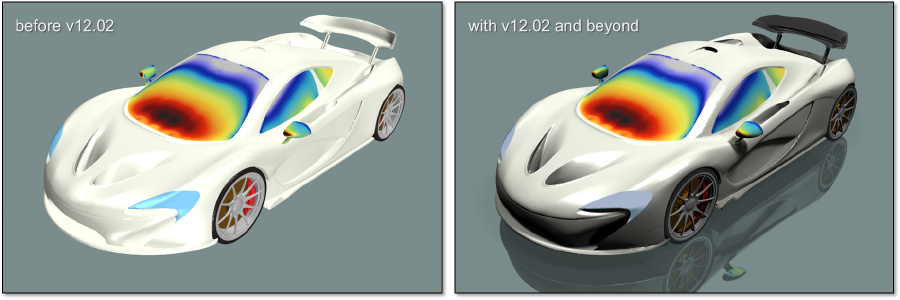Advanced Rendering
Advanced rendering provides realistic visual presentation at an economic computational cost through ray tracing. Ray tracing simulates the travel of light as it passes through the domain and comes into contact with objects in that domain.

Advanced rendering effects are applied on the basis of rendering materials, which are exposed as objects in the user interface.
- In a scene, for scalar displayers, you assign a rendering material type to the displayer, and then Simcenter STAR-CCM+ renders the objects for that displayer as though they were constructed from the rendering material type. For example, if you assign a Metallic rendering material type to the displayer, you can set the Specular Color and Roughness for that displayer, and Simcenter STAR-CCM+ renders the objects accordingly. By default, scalar displayers are assigned a Simple rendering material type that exposes the general properties of absorption, reflection, and refraction.
- For other displayers such as geometry displayers, you can either configure rendering properties in the same way as for a scalar displayer, or else assign a preset rendering material to the displayer.
- Preset rendering materials define rendering properties of a material for objects in non-scalar displayers. Available types are: simple, fresnel, metal, simple metal, matte, emissive, and thin metal. See Rendering Materials.
Advanced rendering effects include:
- Shadows: If a surface is between the light and the rendered surface, the rendered surface is not illuminated by the light.
- Reflection: Surfaces can be given reflective effects through material properties, resulting in mirror effects.
- Refraction: Surfaces can be given refractive effects through material properties. Refraction changes the light directions based on the index of refraction values of air and neighboring objects (for example looking through a clear glass of water).
- Emissive materials: These materials act as a light source, allowing you to add dynamic lighting effects. These lights also serve as a fixed light source.
- Accurate transparency
Using this technique, you can depict your project in a photorealistic display.
| Note | GPU Utilization options do not apply to advanced rendering. (For details about GPU Utilization, see Controlling Graphics Performance.) |
Limitations in the Current Release
- Advanced rendering effects are not supported with the following:
- 3D-CAD views
- Mesh scenes
- Electronics cooling
- Advanced rendering is not performed on the following objects, although these objects are still rendered in the default rendering mode and blended as well as possible with the advanced rendering result:
- Lines
- Points
-
Spheres or other elements rendered as point sprites; for example, such rendering occurs when the Point Scale Mode property of a scalar displayer is set to Pixels.
A point sprite is a quadrilateral 2D space onto which Simcenter STAR-CCM+ projects a view of the 3D geometry without rendering the entire 3D object.
- Text
- Image annotations other than 3D
- Line Integral Convolution
- When spheres or other elements are scaled with certain transformations, advanced rendering does not use implicit representation when a triangulation better matches the intended transformation. For example, when a simple transform with a Scale setting of 2,1,1 is applied to a sphere, that sphere becomes an ellipsoid. The ellipsoid is triangulated and then advanced rendering is applied to the best degree possible.